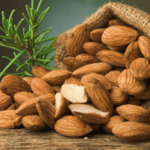What are the Benefits of Almonds?

The almond is a types of tree local to the Center East and South Asia. “Almond” is additionally the name of the palatable and broadly developed seed of this tree. Inside the variety Prunus, it is grouped with the peach in the subgenus Amygdalus, recognized from the other subgenera by the folded shell encompassing the seed. The foods grown from the ground of the almond is a drupe, comprising of an external structure and a hard shell with the seed (which is not a genuine nut) inside. Shelling almonds alludes to uprooting the shell to uncover the seed. Almonds are sold shelled (i.e., after the shells are uprooted), or unshelled (i.e., with the shells still joined). Whitened almonds are shelled almonds that have been treated with heated water to mollify the seedcoat, which is then evacuated to uncover the nut.
Almond Tree:
The almond is a deciduous tree, growing 4–10 m (13–33 ft) in height, with a trunk of up to 30 cm (12 in) in diameter. The young twigs are green at first, becoming purplish where exposed to sunlight, then grey in their second year. The leaves are 3–5 inches long,[1] with a serrated margin and a 2.5 cm (1 in) petiole. The flowers are white to pale pink, 3–5 cm (1–2 in) diameter with five petals, produced singly or in pairs and appearing before the leaves in early spring. Almond grows best in Mediterranean climates with warm, dry summers and mild, wet winters. The optimal temperature for their growth is between 15 and 30°C (60–85°F) and the tree buds have a chilling requirement of between 300 and 600 hours below 7.2°C (45°F) to break dormancy. Almonds begin bearing an economic crop in the third year after planting. Trees reach full bearing five to six years after planting. The fruit matures in the autumn, 7–8 months after flowering.
What are Almonds Nutritional Facts?
The almond is a healthfully thick nourishment and is a rich wellspring of vitamin E, containing 26 mg every 100 g. They are additionally rich in dietary fiber, B vitamins, crucial minerals, for example, magnesium, copper, manganese, calcium, and potassium and monounsaturated fats and polyunsaturated fats (see supplement table), fats which possibly may lower LDL cholesterol. Regular of nuts and seeds, almonds likewise contain phytosterols, for example, Beta-sitosterol, stigmasterol, campesterol, sitostanol, and campestanol, which have been connected with cholesterol-bringing down properties.
Preparatory examination partners utilization of almonds with hoisted blood levels of high thickness lipoproteins and lower low thickness lipoproteins. Almonds may cause unfavorable susceptibility or prejudice. Cross-reactivity is basic with peach allergens (lipid exchange proteins) and tree nut allergens. Manifestations range from neighborhood signs and side effects (e.g., oral unfavorable susceptibility disorder, contact urticaria) to systemic signs and indications including hypersensitivity (e.g., urticaria, angioedema, gastrointestinal and respiratory symptoms). Amid the processing process in people, almond flour may be aged into short-chain unsaturated fats, most quite butyrate which is a substrate for cells lining the internal organ.
